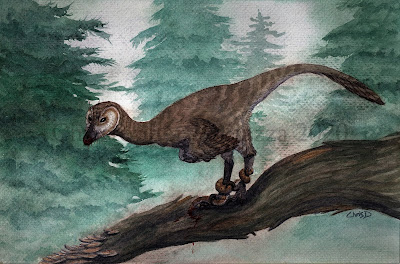 |
| My watercolor life restoration of Pectinodon bakkeri. This animal was likely hunting smaller prey when it was alive, so cretaceous snakes could have been on the menu. |
You may recognize Pectinodon by a different genus name, Troodon. This is because Pectinodon was renamed Troodon during the 1980s. Then in 2011, after further study, it was split back into its own taxa again. In fact, the Troodon genus was split up into multiple taxa based on differences in morphology as well as the fact that all these fossils spanned an extremely long amount of time for only one genus of animal to have been living. The "Troodon" dinosaur that lived during latest Cretaceous in the North American community, called the Hell Creek Formation, was Pectinodon. The original name is still used to describe the family that all these smaller bird-like dinosaurs came from, Troodontidae.
Even though we don't have too much fossil material from Pectinodon, itself, we can make educated inferences about it based on its closest family members that we have more material from. The teeth, which we do have, are sharp and possess deep serrations, but only on the edges that faced the back of the mouth. The teeth are proportionally smaller than those of dromeosaurids, like Velociraptor or Acheroraptor. Other troodontids are known to have had proportionally large, forward-facing eye sockets, suggesting they had good vision and may have even been able to see well in the dark. It is this combination of features that lead many to believe troodontids, like Pectinodon, specialized in hunting small prey, like mammals, and small reptiles.
 |
| Photograph of one of Pectinodon's teeth. Note how the anterior has deep serrations. |
Pectinodon was likely covered in feathers when alive and probably would have looked like a bird to most of us at first glance if we encountered it today. Its legs were probably long and slender, which would have allowed it to have run swiftly if it needed to. This was probably a helpful trait since it would have been pursuing prey as well as avoiding potential predators, like the similarly sized, but more heavily armed, Acheroraptor, and even Tyrannosaurus rex (which was much faster and more agile as a subadult) Being most active at night is also another way to avoid predation and is a tactic used by many animals today.
Like dromaeosaurids ("raptor" dinosaurs, like Velociraptor, and Deinonychus) troodontids, like Pectinodon also had a retractable "killer claw" on each of their second toes, but theirs weren't as proportionally large as those of dromeosaurids. This, combined with the traits already mentioned, further point to them specializing in taking much smaller prey. I imagine troodontids stalking small mammals and reptiles in the thick brush at dusk or at night, using their senses of sight and hearing to zero in, and their long legs to clear tall foliage, then kicking and pinning their target with their special claws when the time was right, and finally dismembering their meal with their serrated teeth. Many modern predatory birds execute similar hunting behavior today in various ways.
References
Currie, P. (1987). "Theropods of the Judith River Formation". Occasional Paper of the Tyrrell Museum of Palaeontology 3: 52–60.
Holtz, Thomas R., Brinkman, Daniel L., Chandler, Chistine L. (1998) Denticle Morphometrics and a Possibly Omnivorous Feeding Habit for the Theropod Dinosaur Troodon. Gaia number 15. December 1998. pp. 159-166.
Larsson, H.C.E. 2001. Endocranial anatomy of Carcharodontosaurus saharicus (Theropoda: Allosauroidea) and its implications for theropod brain evolution. pp. 19-33. In: Mesozioc Vertebrate Life. Ed.s Tanke, D. H., Carpenter, K., Skrepnick, M. W. Indiana University Press.
References
Currie, P. (1987). "Theropods of the Judith River Formation". Occasional Paper of the Tyrrell Museum of Palaeontology 3: 52–60.
Holtz, Thomas R., Brinkman, Daniel L., Chandler, Chistine L. (1998) Denticle Morphometrics and a Possibly Omnivorous Feeding Habit for the Theropod Dinosaur Troodon. Gaia number 15. December 1998. pp. 159-166.
Larsson, H.C.E. 2001. Endocranial anatomy of Carcharodontosaurus saharicus (Theropoda: Allosauroidea) and its implications for theropod brain evolution. pp. 19-33. In: Mesozioc Vertebrate Life. Ed.s Tanke, D. H., Carpenter, K., Skrepnick, M. W. Indiana University Press.
Larson D.W., Currie P.J., 2013, "Multivariate Analyses of Small Theropod Dinosaur Teeth and Implications for Paleoecological Turnover through Time", PLoS ONE 8(1): e54329.


I don't think it is true that Troodon is not longer a valid name. Troodon bakkeri is now Pectinodon bakkeri, but Troodon formosus, the holotype for the genus, is still valid.
ReplyDeleteFrom my understanding it was split into three distinct taxa, Stenonychosaurus, Pectinodon, and Latenivenatrix. Any material perhaps still assigned to the Troodon genus is teeth that are undiagnostic.
Delete